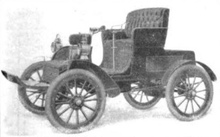Union (automobile)
The Union automobile was based on Lambert's "horseless carriage" gasoline buggy. It had four wheels instead of his 1891 three-wheeled version. The automobile was made by the Union Automobile Company from 1902 through 1905. There were about three hundred Union automobiles made all total.[1]

Description
The Union automobile had an eight-horsepower two-cylinder, four-cycle, double opposed-cylinder gasoline engine. The engine was available in either an air-cooled version or a water-cooled version. The transmission was of the friction type and the final drive by double chain. The body style was a two-seater with a folding collapsible front seat to carry two more passengers,[2] which enabled it to be converted into a four-passenger automobile.[3]
The Union automobile had an experimental model in 1898 and 1901. It was manufactured in Union City, Indiana from parts made in Anderson, Indiana. The first friction disk-drive gearless transmission rear-engine automobile, as designed by Lambert, was in full production in 1902. The motor for the automobile was a pair of opposed 6 x 4-inch (100 mm) cylinders, far in front, crosswise, side chains to rear drivers. This was quickly followed by a second friction driven model, same motor placed crosswise in extreme rear of car.[1]
The Union automobile had a gasoline tank that was built in the back of the seat hidden from sight. It has a capacity sufficient to run the automobile about 125 miles (201 km). The engine was water-cooled with a circulating pump, driven by a gear from the cam shaft. There was a large radiator coil provided. The electric current for ignition was supplied by dry batteries for starting. A generator was used in normal operation. The automobile was equipped with 34-inch (860 mm) pneumatic tires. Kerosene oil lamps were furnished it came with enameled sheet steel mud guards.[3]
The Union automobile had a special hand brake controlled by the left foot. The friction disk-drive transmission made an emergency brake, being operated by throwing it in the reverse position. The operator controlled the steering wheel with his right hand and the speed changing lever with his left hand. The speed of the motor could be varied from 150 revolutions per minute to over 1,500 revolutions per minute. This variation of speed of the motor, in addition to the variable speed from the transmission, allowed a wide range of speed for the Union automobile.[3] The transmission was enclosed in a dustproof casing and ran in oil. One lever controlled two forward speeds and one reverse. The high speed was 20 miles per hour (32 km/h).[2]
Footnotes
- G.N. Georgano, p. 853
- "The Union Automobile." Cycle and Automobile Trade Journal, June 1902, p 70.
- The Horseless Age, p. 701
See also
Primary sources
- Biography of John W. Lambert, written by his son January 25, 1935 — obtained from the Detroit Public Library, National Automotive History Collection
- Dolnar, Hugh, Automobile Trade Journal, article: The Lambert, 1906 Line of Automobiles, Chilton Company, v.10 January 1906
- Forkner, John L., History of Madison County, Indiana, New York and Chicago, The Lewis Publishing Company, 1914
- The Horseless Age: The Automobile Trade Magazine, The Horseless Age Company, 1902
Secondary sources
- Bailey, L. Scott, Historic Discovery: 1891 Lambert, New Claim for America's First Car, Antique Automobile magazine, Vol. 24, No. 5, Oct–Nov 1960
- David Burgess Wise, The New Illustrated Encyclopedia of Automobiles ISBN 0-7858-1106-0
- Dittlinger, Esther et al., Anderson: A Pictorial History, G. Bradley Publishing, 1990, ISBN 0-943963-16-8
- G.N. Georgano, The Beaulieu Encyclopedia of the Automobile, Taylor & Francis, 2000, ISBN 1-57958-293-1
- Huffman, Wallace Spencer, Indiana's Place in Automobile History in Indiana History Bulletin, vol 44, no. 2, Feb. 1967; Indianapolis, Indiana Historical Bureau
- Huhti, Thomas, The Great Indiana Touring Book: 20 Spectacular Auto Tours, Big Earth Publishing, 2002, ISBN 1-931599-09-2
- James, Wanda, Driving from Japan, McFarland, 2005, ISBN 0-7864-1734-X
- Kimes, Beverly Rae, Standard Catalog of American Cars, 1805-1942, Krause Publications, 1996, ISBN 0-87341-428-4
- Madden, W. C., Haynes-Apperson and America's First Practical Automobile: A History, McFarland, 2003, ISBN 0-7864-1397-2
- Scharchburg, Richard P., Carriages Without Horses: J. Frank Duryea and the Birth of the American Automobile Industry, SAE, 1993, ISBN 1-56091-380-0